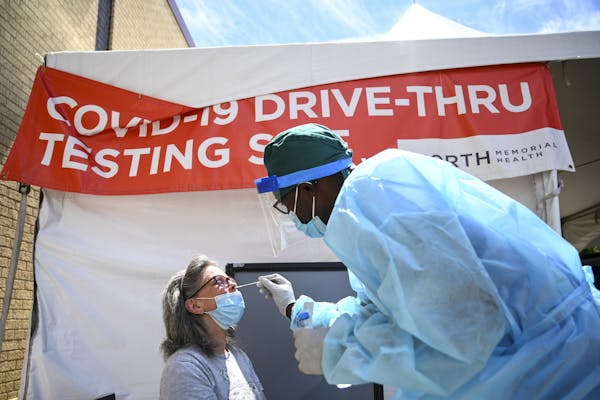After steadily growing from mid-June to late July, the volume of new coronavirus cases reported in Minnesota has stabilized, and the number of deaths disclosed daily remains relatively low.
Those are encouraging signs, yet health officials remain uneasy because the volume of new cases is considerably higher in August than it was in June, said Kris Ehresmann, director of infectious disease at the Minnesota Department of Health.
Interviews with those testing positive show a significant number likely were exposed at events where people gathered in groups without wearing masks or social distancing, Ehresmann said Saturday. And the state seems poised for more transmissions this fall as some schools reopen and cooler weather forces people indoors.
"Things definitely have stabilized, but they've stabilized at a pretty high rate," Ehresmann said.
"We're kind of in a bit of a holding pattern," she added. "I think what keeps all of us in public health from being too excited is the fact that we haven't gone down — we had fewer cases for a while, and we aren't going back to that number."
The Health Department on Saturday reported 696 newly confirmed cases of people infected with the novel coronavirus, as well as six more deaths. Four of the deaths were in residents of long-term care and assisted living facilities. Residents of those facilities now account for about three-quarters of the 1,699 deaths reported in Minnesota throughout the pandemic.
All six deaths reported Saturday were in people age 70 and older. That age group has accounted for about 80% of all Minnesota deaths attributed to COVID-19.
Saturday's report ended a week that included 12 deaths reported Wednesday — the first day of double-digit deaths since July 2 — as well as a two-day period with an average of about 400 new cases per day, an unusually low number.
With the anomalies, the seven-day average for deaths on Saturday was higher than in recent weeks at just over seven deaths per day, while the seven-day average for new cases fell to the lowest level in more than three weeks.
Even so, the general trend of stability remains, Ehresmann said.
Deaths in August are down considerably from May, when the state averaged more than 20 deaths per day. Daily counts for new cases this month have been averaging well above 600, and hit 700 at times, compared with June averages that were consistently below 400 new cases per day.
The higher levels are concerning, Ehresmann said. Also troubling is that Health Department interviews with people who test positive suggest that more people don't know where they are contracting the virus.
"They are involved in so many things that were potential exposures," Ehresmann said. "It's not like, 'Oh, I only saw three people in the last week and so this is where I might have been exposed.' It's like, 'I've been to so many places, and been exposed to so many people, that I don't have any idea.' "
Seneca Foods outbreak
Saturday's data release showed nine more cases in McLeod County, about an hour west of the Twin Cities. Over the past week, the county's case count has jumped by 76 cases — or about 43% — to 249, according to the Star Tribune data.
Ehresmann said many cases in the county have been tied to an outbreak among workers at Seneca Foods, in the county seat of Glencoe. The company provides dorms to house migrant workers, she said, and that sort of housing can enable the virus to spread.
"There's more testing coming … so we should have more information next week," Ehresmann said.
Numbers released Saturday show 307 patients were hospitalized across Minnesota, including 140 who required intensive care. The counts were down slightly from Friday's data release.
Daily tallies for hospitalized patients in Minnesota have been rising a bit or holding steady in recent weeks. Yet they remain well below peaks of more than 600 hospitalized patients and about 260 in the ICU in late May.
COVID-19 is a viral respiratory illness caused by a new coronavirus that was found circulating late last year. Since the first case was reported in Minnesota in early March, hospital stays have been required in 5,822 cases.
People at greatest risk from COVID-19 include those 65 and older, residents of long-term care facilities and those with underlying medical conditions.
Health problems that increase risks range from lung disease and serious heart conditions to severe obesity and diabetes. People undergoing treatment for failing kidneys also run a greater risk, as do those with cancer and other conditions where treatments suppress immune systems.
Most patients with COVID-19 don't need to be hospitalized. The illness usually causes mild or moderate sickness; studies suggest that up to 45% of those who are infected won't have symptoms.
Minnesota has seen a total of 64,413 cases since the start of the pandemic. Of those, 57,457 patients no longer need to be isolated.
On Friday, the U.S. Centers for Disease Control and Prevention clarified a recent update to its isolation guidance, saying it's not necessary to retest someone in the three months following initial infection unless that person shows unexplained symptoms.
The announcement speaks to the unanswered question, Ehresmann said, of whether people who are infected with the novel coronavirus can become reinfected later.
"We have not been made aware of any duplicates at this point," she said. "We've had people who have obviously tested positive for a while — meaning it's taken a while before they revert to negative, but it's not necessarily that they've had a second disease."
Christopher Snowbeck • 612-673-4744
8 months in jail for Blaine man who caused 120-mph crash hours after he was caught speeding

Daughter sues St. Paul, two officers in Yia Xiong's killing

